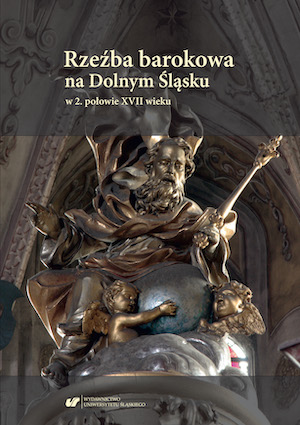Epitafium burmistrza Martina Schmidta z kościoła św. Mikołaja w Brzegu – zapomniany przykład snycerki śląskiej 2. połowy XVII wieku
The epitaph of Mayor Martin Schmidt from the Church of St. Nicholas in Brzeg – a forgotten example of Silesian woodcarving of the second half of the 17th century
Author(s): Romuald Nowak
Subject(s): Fine Arts / Performing Arts, Visual Arts, History of Art
Published by: Wydawnictwo Uniwersytetu Śląskiego
Summary/Abstract: The wooden epitaph of the Mayor of Brzeg Martin Schmidt (1583–1668) was initially, i.e. in 1668, placed above the so-called parish priest stalls on the wall of the southern nave of the Church of St. Nicholas in Brzeg, to the left of the entrance to the vestry, next to another monumental epitaph of the family of deacon Daniel Kartscher (d. 1685). During a fire in February 1945 it probably burned down together with the rest of the furnishings. Fortunately, a very good quality photograph has survived, enabling us to analyse the work.
The epitaph commemorated one of the most distinguished mayors in the history of Brzeg, a man who remained in his office for 45 years. It had a three-part architectural structure, which drew on the traditional form of late Renaissance epitaphs of burghers. The central part was an oval plaque with a Latin inscription referring to the deceased and his wife Barbara Runtzkin. It was flanked by two Corinthian columns, next to which there stood personifications of the cardinal virtues of Justice and Prudence. The epitaph was crowned with a broken volute cornice. In its centre, there was a low relief coat of arms of the Schmidt family and above it on a base – a tondo with a bust of the deceased painted on metal. The lower part of the work was a suspended cartouche in the form of a frame formed by an auricular ornament complemented by bunches of flowers and fruit, flanked by two atlas putti. It was filled with an emblematic picture painted on wood and stressing the need to remain vigilant in life to ensure constant Divine protection.
The author of such a programme was probably Martin Schmidt himself. He was a well-educated man and a friend of many professors from the Brzeg Gymnasium Illustrae. Being on good terms with people at the court of George III of Legnica and Brzeg, he was probably in touch with the artists working there – the author of the portrait as well as the marine representation in the cartouche was Ezechiel Paritius (1622–1688), from 1662 a court painter to Dukes of Legnica and Brzeg.
It is more difficult to identify the author of the early Baroque carved framing of the epitaph. However, if the founder used the services an eminent local artist associated with the court of the Legnica–Brzeg Piast dukes in the making of the painted part of the epitaph, he must have done the same when commissioning its carved decorations. The only artist who could make carved decorations of the epitaph of Martin Schmidt in Brzeg at the time was the Bohemian-born sculptor Lucas Müller (ca 1620–1689). As the co-author of the sarcophagus of Duke George III he must have been regarded as worthy of making an epitaph for Schmidt together with the court painter Paritius. This may have been the work that earned him the rights of the city of Brzeg he was granted in the same year in which Mayor Schmidt died.
Book: Rzeźba barokowa na Dolnym Śląsku w 2. połowie XVII wieku
- Page Range: 29-39
- Page Count: 12
- Publication Year: 2020
- Language: Polish
- Content File-PDF

